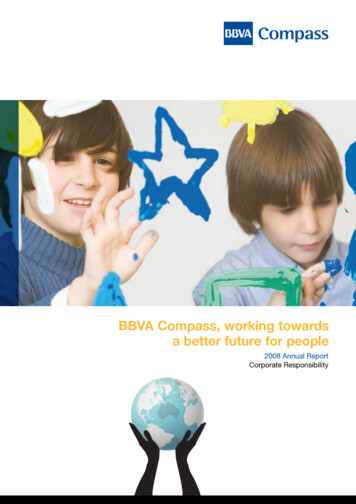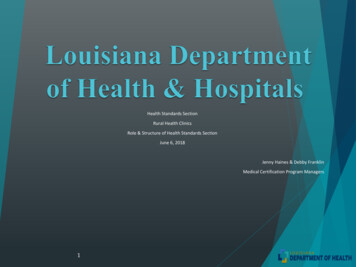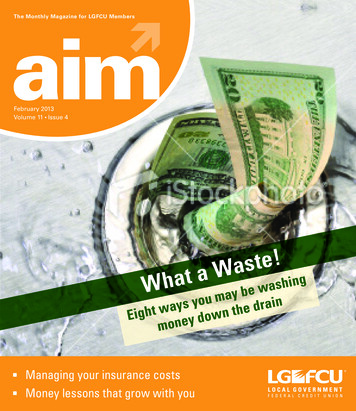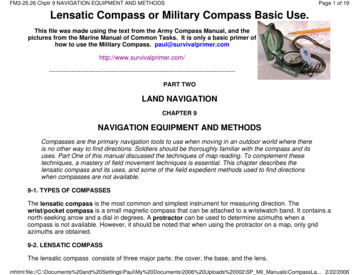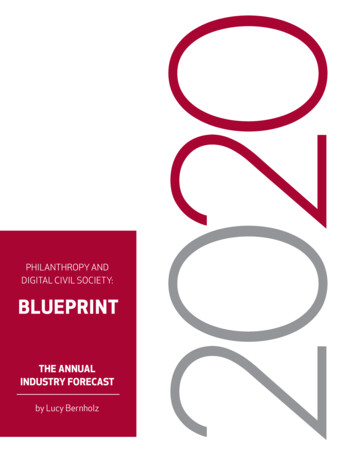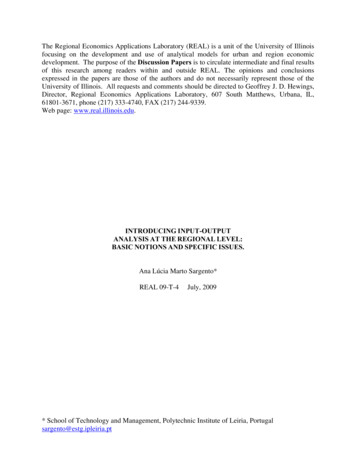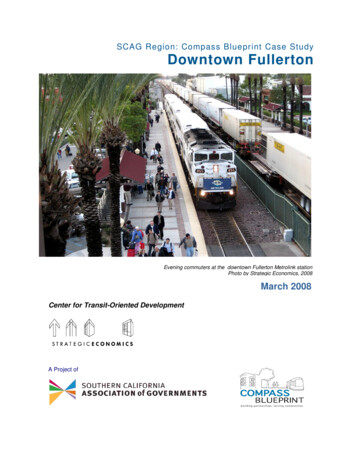
Transcription
SCAG Region: Compass Blueprint Case StudyDowntown FullertonEvening commuters at the downtown Fullerton Metrolink stationPhoto by Strategic Economics, 2008March 2008Center for Transit-Oriented DevelopmentA Project of
Figure 1. Transit, Housing, andHistory in Downtown FullertonDOWNTOWN FULLERTONFullerton is a city in north Orange County, just north of Anaheimand other major employment centers and destinations. Thecommunity began as a railroad town, and its historic downtownevolved around the City’s train station. In the last several years,downtown Fullerton has become a hot spot of activity,accommodating many restaurants, new housing, and stores. Thiscase study examines the City’s efforts over the last two decadesto revitalize the downtown by capitalizing on the district’s transitaccessibility and rich legacy of historic buildings.LOCAL CONTEXTThe City of Fullerton began as a railroad town, named after theagent of the Santa Fe Railroad Company who purchased theright-of-way for a new railroad that would run through the city.Fullerton’s economy boomed through most of the 20th century,fueled by food packing, oil fields, aviation and, following WorldWar II, massive housing construction for returning veterans andtheir families.The City’s downtown sprang up around the Santa Fe RailroadDepot, which remains an important landmark and transportationhub. The station is now served by Metrolink and Amtrak trains,and is the busiest Metrolink station in Orange County. Inaddition, the station serves as a hub for Orange CountyTransportation Authority (OCTA) buses. These transit optionsallow residents to commute to and from Los Angeles, Irvine, andeven San Diego. I-5, SR-91, and SR-57, as well as HarborBoulevard, a major regional arterial that runs through the centerof the downtown, further reinforce Fullerton’s accessibility.Fullerton’s older housing stock, much of which was built in thedecades following World War II, makes the City more affordablethan many in Orange County. The City’s median income in2006 was 62,124, significantly less than the County median of 70,232. However, incomes and housing prices are risingthroughout Orange County, driving middle-income workers tolive further inland and commute long distances. Fullerton hastaken advantage of these trends as it has revitalized itsdowntown, building multi-family, infill development to attractyoung couples and seniors who might otherwise be priced out ofthe area, and drawing visitors from across the increasingly welloff region to its many restaurants and nightclubs.Source: Strategic Economics, 20082
Figure 2. Employment Densities in Orange CountySource: Center for Neighborhood Technology3
REVITALIZING DOWNTOWN FULLERTONFullerton’s downtown revitalization effort began to take off inthe early 1990’s, when the City enacted the first in a series ofpolicies that helped attract new restaurants and residentialdevelopers. Over the last decade and a half, these policies havehelped restore more than 70 historic buildings, attractapproximately 40 restaurants and nightclubs, and produce fourmajor mixed-use developments that added hundreds of units tothe downtown housing stock.1 The resulting influx of shoppers,diners, and residents has made downtown Fullerton a bustlingcenter of activity. Currently, the City is focused on extending itssuccess to southern downtown by expanding the FullertonTransportation Center, which will be surrounded by a mix ofresidential, retail, office, and cultural facilities.The study area for this profile encompasses the historicdowntown as defined by the Redevelopment Agency, as well asthe South of Commonwealth (SOCO) District and the site for theproposed Fullerton Transit Center (Figure 4).Figure 3. Railroad DaysSource: www.trainweb.comEvery year, tens of thousands of people gather indowntown Fullerton to celebrate the City’s colorfulrailroading history.NEIGHBORHOOD HISTORYFullerton’s downtown prospered from the City’s founding in the1880’s through the first part of the 20th Century. In the 1970’s,however, growth slowed and the downtown fell into decline asnew suburban malls drew business away from the historic core.By the early 1990’s, downtown was dominated by pawnshops,tattoo parlors, antique stores and vintage clothing stores.In order to draw new life into the district, Fullerton focused onthe downtown’s assets, particularly the many historic,architecturally valuable buildings. Beginning in the early1990’s, the City conducted several planning efforts to guidefuture development. Led by an Ad Hoc Committee of volunteercitizens, Fullerton revised its design guidelines to ensure that thedistrict’s historic urban character would be preserved. At thesame time, the City conducted an extensive outreach process andpublished a Transportation Center Study that developed land use,circulation, parking, urban design and public art concepts for theMetrolink/Amtrak station area. In 2005, the City published anupdated Downtown Strategy that laid out new goals andstrategies designed to build on the successes of previous efforts.“You go back to theorigins of Fullerton,and it’s centeredaround the railroads.Flash forward totoday, and we’ve gothe busiest rail stationin Orange County.”- Robert Zur Schmiede,Redevelopment AgencyExecutive Director (fromOrange County Register,February 14, 2006)1City of Fullerton, “Oranges and Oil – A Fullerton wwithCharlesKovac,Redevelopment and Economic Agency Project Manager, StrategicEconomics, January 14, 2008.4
Planning Timeline:1991- Redevelopment Agencylaunches seismic retrofitting andcommercial rehabilitation loanprogram1995 – Agency adopts theFullerton Transportation CenterStudy, providing guidelines fordowntown development1996 – Redevelopment Agencyadds tenant improvements loanprogram2002 – City Council createsRestaurant Overlay District (ROD),reducing parking requirements forcertain restaurants2005 – Redevelopment Agencypublishes the Fullerton DowntownStrategyFullerton’s early planning effortsand commercial rehabilitation loanprograms won several awards in themid-1990’s, including the League ofCalifornia Cities’ Helen PutnamAward in Economic and CommunityDevelopment, an AchievementAward from the CaliforniaDowntown Association, and anhonorable mention from theNational League of Cities in itsannual James C. Howland Awardsfor Urban Enrichment. In 2007, theCity won a SCAG’s CompassBlueprint Program President’sAchievement Award for theFullerton Transportation Centerexpansion plans (see text box, below,for more information).Meanwhile, the City has implemented highly successfulprograms to attract new businesses. In the early 1990’s, theRedevelopment Agency began offering loans to help localproperty and business owners with seismic retrofitting,commercial building rehabilitation, and tenant improvements. In2002, the City established a Restaurant Overlay District thatloosened parking requirements for certain downtown restaurants,thus further encouraging downtown businesses.While the loan programs and reduced parking requirementsattracted many new businesses, the downtown’s success wasgreatly enhanced by the accompanying construction of newhousing. Attracted by Fullerton’s transit accessibility, retail, andrestaurants, four private developers have built major mixed-useresidential projects since 1991, adding over 640 housing units(most of them rental) and almost 26,000 square feet of retail tothe downtown. In the meantime, the Redevelopment Agencyconstructed or rehabilitated a total of nearly 200 affordableand/or senior housing units.2 The new residents are key tomaking downtown a vital urban environment, providing roundthe-clock activity on the streets and a base of support for the newshops and restaurants.Today, downtown Fullerton is becoming known as a regionalhub for dining and nightlife. Diners can find anything fromMexican, Mediterranean, Japanese, French and Italian finedining to British-style pubs and neighborhood bar and grills.The neighborhood has retained many of the funky vintageclothing and furniture stores that once dominated the area, whilegaining new, higher-end boutiques. In addition to attractingvisitors from throughout Orange County, the downtown servesas a community center, home to a seasonal farmer’s market andannual events such as “A Night in Fullerton,” a celebration oflocal cultural resources, and “First Night Fullerton” on NewYear’s Eve, and “Railroad Days” (Figure 3).2Fullerton Redevelopment Agency, January 2008.5
Figure 4. Downtown FullertonSource: Southern California Association of Governments; study area delineated by Strategic Economics, 20086
HOW DID THEY DO IT?Figure 5. Historic Santa Fe DepotSource: Strategic Economics, 2008The Spanish Revival style Santa Fe Depot wasbuilt in 1930 to replace the original Victoriandepot. The Redevelopment Agency tookownership in 1991 and fully rehabilitated thebuilding, restoring the original stucco finish onthe exterior and replicating or restoring many ofthe interior features.Since the early 1990’s, Fullerton has focused on reinforcingdowntown’s historic urban character and attracting newbusinesses and residents. The city’s successful strategies haveincluded: Restoring historic buildings Providing incentives for small businesses Improving infrastructure Attracting transit-oriented, mixed-use development Promoting downtown as a destinationRestoring historic buildings: Fullerton’s emphasis on restoringits historic buildings sets the city apart. The RedevelopmentAgency’s seismic and commercial loan program, launched in1991, has been a major driver in preserving the district’s uniquehistoric character. The program provides matching loans for therehabilitation and seismic retrofitting of downtown historicstructures, particularly commercial buildings made ofunreinforced masonry. Since its inception, the loan program hasfacilitated the rehabilitation of over 70 historic buildings. Whilemost of downtown’s historic buildings have now beenreinforced, the seismic retrofitting program continues today. In2006, the Agency approved a 1.25 million seismicrehabilitation loan to renovate the eighty year old Fox Theater asa pedestrian-oriented cultural complex. The Agency has alsotaken direct responsibility for rehabilitating some buildings,including the Santa Fe Depot (Figure 5).Providing incentives for small businesses: While therehabilitation loan program helped property owners make theirbuildings safe and functional for modern uses, the City createdadditional incentives directly targeted at attracting small businesstenants. In 1996, the Redevelopment Agency launched a TenantImprovement Loan Program designed to attract businesses byproviding assistance for tenant-specific improvements. In 2002,recognizing that on-site parking requirements posed a barrier fornew and expanding restaurants, the City created a RestaurantOverlay District (ROD). The ROD relaxes the on-site parkingrequirements for restaurants with fewer than 200 seats. In orderto accommodate the increased parking needs, the City builtseveral free and low-cost parking structures, encouragingdowntown visitors to “park once.”Improving infrastructure: In addition to building public parkingstructures, Fullerton has invested millions of dollars inimproving downtown’s appearance and safety.TheRedevelopment Agency contributedtwo million dollars inpublic improvements and signage for the SOCO Walk project.Other projects include providing free wireless throughout7
downtown and upgrading underpasses, sidewalks, lighting, andlandscaping.Figure 6. SOCO WalkAttracting transit-oriented, mixed-use development: Every day,3,000 people pass through the Fullerton Metrolink Station,making the station the busiest in Orange County and the thirdbusiest in the Metrolink system.3 Transit is a big draw fordevelopers and residents alike, particularly since Metrolink isexpected to substantially increase the level of service by 2009.Local apartment complexes advertise, “Commuting is as easy asa walk to the Metrolink train station across the street,”4 and in2005, Fullerton residents ranked the “rail station in [the] centerof town” as their favorite downtown feature.5Downtown’s transit accessibility and cultural amenities haveattracted four major mixed-use development projects since 1991.Wilshire Promenade, City Pointe, and Pinnacle at Fullerton,three luxury complexes with ground floor retail, havecollectively added 540 rental units to downtown. Most recently,the City partnered with the Olson Company to build SOCOWalk, a development of for-sale townhomes, live-work units andlofts located to just across the tracks from the Metrolink/Amtrakstation (Figure 6). SOCO Walk forms the cornerstone ofFullerton’s new South of Commonwealth (SOCO) District,which also includes a number of restaurants, lounges andboutiques just north of the railroad tracks. The proposedFullerton Transportation Center, a 35-acre project that willsurround the existing Metrolink/Amtrak station and incorporateresidential, retail, office, open space and cultural uses, will roundout the development of the SOCO District.Source: Strategic Economics, 2008SOCO Walk, located just south of the trainstation, will include 120 townhomes, livework units and lofts and 1,720 square feetofretailwhencompleted.TheRedevelopment Agency invested 2 milliondollars in the project for signage and otherpublic improvements.PLANNING THE FULLERTON TRANSPORTATION CENTERIn 2007, the City of Fullerton won SCAG’s Compass Blueprint Program’s first President’s Achievement Award for VisionaryPlanning in Mobility, Livability, Prosperity & Sustainability for the Fullerton Transportation Center plans. Fullerton envisions “avibrant and active mixed-use Transit Center with shops, restaurants, offices and housing located in high-quality contemporarybuildings”* which will serve as an anchor for the southern part of downtown. JMI Realty and The Morgan Group, twocompanies with experience building major downtown projects, have been selected to develop the 35-acre site surrounding theMetrolink/Amtrak Station. While the plans in progress, the Redevelopment Agency and developers are committed topreserving the site’s historic buildings, incorporating cultural and civic spaces, and providing bicycle, pedestrian and busaccess.* City of Fullerton Redevelopment Agency, “Fullerton Downtown Strategy: Update to the 1995 Transportation CenterStudy,” December 2005.3City of Fullerton, “The Fullerton Transportation Center is Going Places,”Focus On Fullerton, January 2006.4Pinnacle at Fullerton website, http://www.pinnacleatfullerton.com/.5City of Fullerton Redevelopment Agency, “Fullerton Downtown Strategy:Update to the 1995 Transportation Center Study,” December 2005.8
MEASURING SMART GROWTH:HOW DOES DOWNTOWNFULLERTON COMPARE?Figure 7. Housing Costs as a Percent of IncomeFigure 8. Housing and Transportation Costs asa Percent of IncomeDowntown Fullerton enjoys lower than average housing and transportation costs. While housing costs are typically similarin the City of Fullerton and the Orange County, the Downtown Area maintains significantly lower housing costs than therest of the region, most likely because units are smaller rather than because they are more affordable overall. DowntownFullerton’s transportation costs are also lower than average. The neighborhood is served by both bus and rail service andthe area enjoys a mix of employment, retail, service, and residential uses. New residential and mixed-use growthoccurring in the area will further enhance this land use mix.9
MEASURING SMART GROWTH:HOW DOES DOWNTOWNFULLERTON COMPARE?Comparison of Current and Future Housing, Transportation, and Combined CostsThe City of Fullerton enjoys lower thanaverage combined H T costs for OrangeCounty. Housing costs are particularlylow. It is worth noting that averageOrange County H T costs are nearly tenpercent higher than the SCAG regionalaverage.DowntownFullertonCity ofFullertonOrangeCounty% Income Spent on Housing23%30%36%% Income Spent on Transportation23%25%25%Combined46%55%61%Fullerton Housing and Transportation Rank Relative toOther Communities:Housing Cost: 216th of 338 (near Anaheim, Costa Mesa, Chino)Transportation Cost: 111th of 338 (near San Fernando, Artesia)H T: 208th of 338 (near Palmdale, Los Alamitos, Carson)Smart Growth ScoresSmart Growth Factors Affecting Transportation AffordabilityThe table to the right showssome of the smart growthfactors that affect theaffordability oftransportation, as reportedabove.Fullerton’s transit connectivityis nearly twice the averagefor the region, jobs arerelatively highlyconcentrated, and theneighborhood is highlywalkable due to low blocksizes and a diverse land usemix. As a result, the averagejourney to work is lower thanaverage and households tendto own fewer cars.By continuing to add highdensity housing near transit,Fullerton will further lowertransportation costs.Block SizeAverage in theSCAG RegionDowntownFullertonHow to Read:27.5 Acres10.5 AcresA smaller block size provides a morewalkable environmentTransit ConnectivityIndex1,8043,447The greater the transit connectivity, themore likely it is residents will taketransit, developers will build neartransit, etc.Land Use MixIndex0.460.50A greater mix of land uses enables localresidents to access shopping andservices without driving72,241The closer a community is to jobs, theshorter the commutes. Shorter rides canalso encourage commuters to usealternative transportation.Jobs per Square Mile inNearby Areas57,269Households per Acre6.510.2More compact development can supporta wider variety of retail and services,and make walking to these serviceseasierAverage Journey to WorkTime28.5 Minutes25.2 MinutesShorter commutes lead to cost savingsin gas and other transportationexpenditures (and reduce emissions)Cars per Household1.71.4Car ownership rates can be influencedby local income levels, and by whereyou liveSCAG Composite ScoreDowntown Fullerton Current ScoresTransit Service:7.9ofWalkability:5.2ofLand Use Mix:5.5ofOverall Neighborhood Rank:6.2ofSource: Fregonese Calthorpe & Associates1010101010
LESSONS LEARNEDTake advantage of historic buildings,surrounding opportunity sites, andother local resources.Fullerton has established a unique identity for itsdowntown by restoring the many historicbuildings. The City has also taken advantage ofthe large opportunity sites that surrounddowntown.Many historic city centers areconstrained by small parcel sizes that make itdifficult to catalyze growth with large residentialprojects.Fullerton’s railroading history,however, has left the City with many largeindustrial sites on the southern edge ofdowntown. By building significant, mixed-usehousing projects such as SOCO Walk and theFullerton Transportation Center on these sites,the City will help boost demand for transit andthe shops and restaurants in the core ofdowntown.Downtown revitalization is a complex,long-term process.Downtown Fullerton’s current success representsthe fruition of decades of hard work. Thecommunity began planning and implementingincentive programs in the early 1990’s, and thefirst significant multi-family housing project, theWilshire Promenade, opened in 1991. Only inthe last few years, however, has the downtownseemed to reach a critical mass of residents andcommercial attractions.Catalyst projects should be coupledwith smaller scale investments, likesupporting small businesses andtenant ofitting, commercial rehabilitation, and tenantimprovement loan programs were clearly acrucial component of the downtown’s rebirth.Indeed, Fullerton’s most significant projects havehardly had time to affect downtown; SOCO Walkhas only just opened, and the FullertonTransportation Center is still in early planningstages. The Agency’s smaller scale programs, onthe other hand, have assisted private propertyowners and merchants over the past decade and ahalf, slowly but steadily encouraging the creationof dozens of restaurants, nightclubs, and shops.Parking management tools canfacilitate infill development.In many cities, parking requirements hinder thegrowth of small business and drive urban form,forcing restaurants and stores to build parking atthe expense of floor space. Parking is also a sourceof frustration to retailers, who require assurancesthat their customers will be able to find aconvenient parking space. Fullerton’s RestaurantOverlay District (ROD) and public parking lotsalleviated these pressures, allowing businesses togrow without worrying about parking.ACKNOWLEDGEMENTSThe following individuals provided information for this case study:For more information, contact:Charles Kovac, Project Manager, Redevelopment and EconomicDevelopment DepartmentHeather Allen, Senior PlannerJoseph CarrerasProgram Manager,Housing and Community PlanningSouthern California Association of Governments213-236-1856Lead authors: Abby Thorne-Lyman, Strategic EconomicsAlison Nemirow, Strategic Economics11
Depot, which remains an important landmark and transportation hub. The station is now served by Metrolink and Amtrak trains, and is the busiest Metrolink station in Orange County. In addition, the station serves as a hub for

